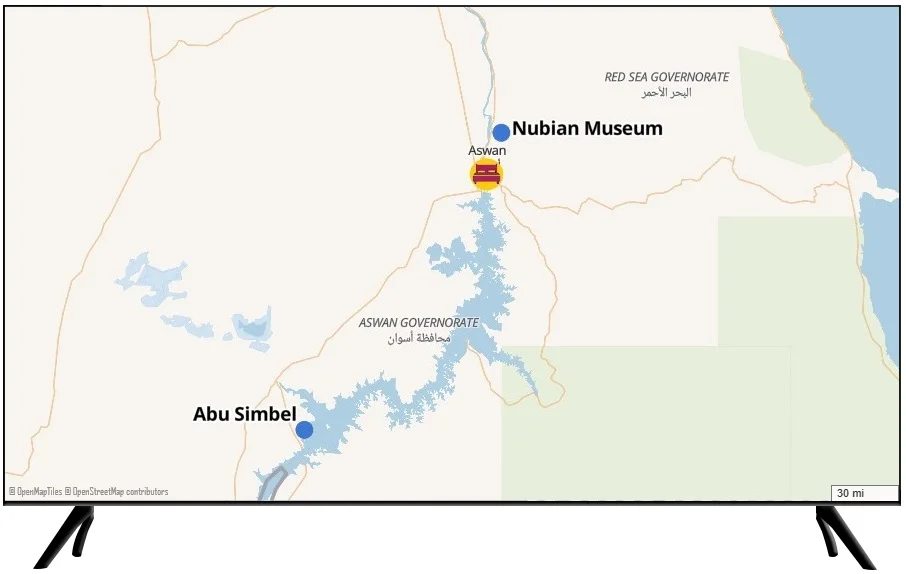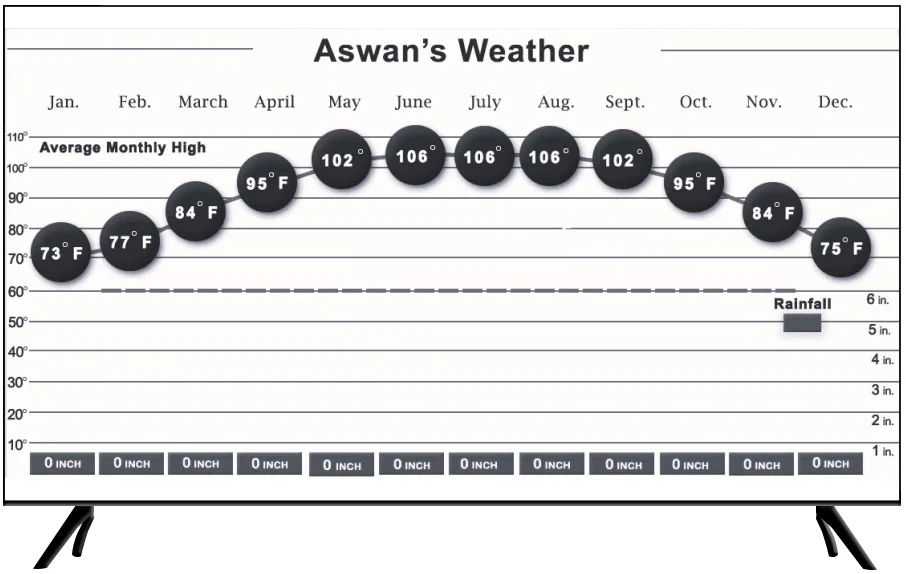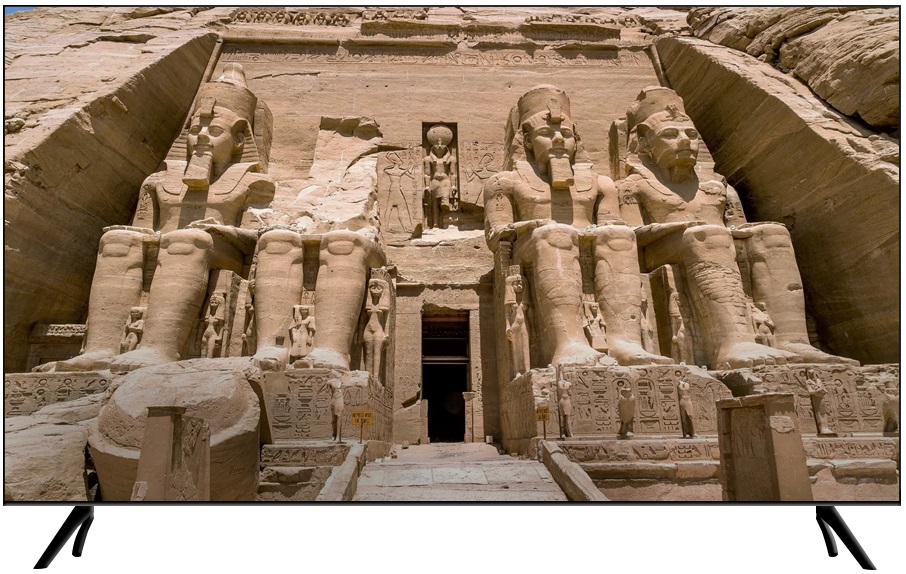


Day 5. Aswan – Abu Simbel Excursion
Overnight - Sofitel Legend Old Cataract
In the morning your Egyptologist Tour Director will accompany you to the Aswan airport and assist you in boarding the short flight to Abu Simbel. Arrive at Abu Simbel and you are ushered to your private vehicle and driven to Ramses II’s most awe-inspiring creation.
Located on the western banks of Lake Naseer, these colossal temples are still accessible to humanity because of one of the most amazing archaeological engineering feats of all time. Between 1964 and 1968 everything in and outside these temples were cut into massive blocks weighing up to 30 tons each and transported to a location 213 feet higher than where they were originally constructed. UNESCO and the Egyptian Government orchestrated a massive campaign with a large and diverse international team of specialists and accomplished this incomprehensibly difficult project so as to save the temples from the rising waters of the Nile to be caused by the impending opening of the Aswan High Dam.
The Abu Simbel Temples are part of the ‘Nubian Monuments’ UNESCO World Heritage Site, which also includes Philae, near Aswan. Built in the 13th Century BC over 20 years, these two temples were created to establish, in the minds of the Nubian people, Ramses II’s power and near-divinity, as well as the might of Egypt. The first temple, known as The Great Temple, has four massive 66-foot-tall statues of Ramses II seated on thrones at its entrance, and is widely considered to be one of the most beautiful temples in Egypt. Much smaller statues of the royal family, including his wife Nefertari, are situated around the seated monarchs’ legs. Amazing historic treasures await visitors inside the temple, which has a triangular layout reducing in scale as you go deeper to the main sanctum. There are beautiful statues, gorgeous bas-reliefs, impressive pillars, and objects devoted to the three ancient Egyptian Gods to whom Ramses II dedicated this temple.
A short distance away is The Small Temple, dedicated to Goddess Hathor and Queen Nefertari. This temple is only the second temple in Ancient Egypt’s many millennia long history that is dedicated to the consort of a king, and is one of the very few times such a major monument presented statues of the king and his queen that were equal in size. Surrounding the entrance are three 33-foot statues on each side, with statutes of Ramses II bookending the two statues of Queen Nefertari on both sides. The interior of the temple offers amazing treasures and is similarly beautiful as The Great Temple, although smaller in scale.
After exploring these wonders, you will return to the airport and fly back to Aswan, returning to your hotel for some relaxation.
In the afternoon you will visit another of the Aswan regions greatest attractions, the Temple of Isis. Philae Island was the original island home of these massive structures and they were moved as part of the incredible project that moved Abu Simbel’s Temples. This awe-inspiring complex was moved to Agilika Island by the Egyptian Government and UNESCO as Philae Island had existing flooding issues even before the Aswan High Dam was constructed – it is now mostly submerged.
The Temple of Isis on the island is a part of the Nubian Monuments UNESCO World Heritage Site and was dedicated to the Gods Isis, Osiris, and Horus. Among other subjects, the amazing bas-reliefs on the temple’s walls portray how Isis brought Osiris back to life, gave birth to Horus, and mummified Osiris after his death. It is purported to be Osiris’ final resting place. Originally built around 700 BC, the temple complex had subsequent additions made by both Egyptians and, later on, Roman rulers. The Temples of Philae were a major pilgrimage site for Nubians, Egyptians, and people from faraway lands. The amazing details on the walls, statues and columns are among the most impressive you will find anywhere, and the worship of Isis continued here until the 6th Century.
Christians had established a foothold on Philae during the fourth century, and they initially co-existed with the ongoing religious practices at the Philae Temple. In the 6th century they took over and converted parts of the complex to a church, defacing a number of significant monuments and structures in the process. Just as many of Ancient Egypt’s most important sites, some of the most valuable artifacts of the Temple were removed by European archaeologists during later colonial times. Your visit will include the Pylon Panorama Ticket, which allows you to use the steps to reach the roof of a Pylon and take in the incredible views of the complex and the Nile.
In the early evening you have two options to select from. The first option is boarding a traditional felucca and enjoy a cruise on the Nile and watch the spectacular sunset over this fabled region. The other option is to return to Philae Island by speedboat for the Sound and Light Show. We do not recommend most Sound and Light shows at any of the destinations we offer as they are usually sub-standard, but the Philae Temple spectacle is an exception and is worth experiencing.
In the morning your Egyptologist Tour Director will accompany you to the Aswan airport and assist you in boarding the short flight to Abu Simbel. Arrive at Abu Simbel and you are ushered to your private vehicle and driven to Ramses II’s most awe-inspiring creation.
Located on the western banks of Lake Naseer, these colossal temples are still accessible to humanity because of one of the most amazing archaeological engineering feats of all time. Between 1964 and 1968 everything in and outside these temples were cut into massive blocks weighing up to 30 tons each and transported to a location 213 feet higher than where they were originally constructed. UNESCO and the Egyptian Government orchestrated a massive campaign with a large and diverse international team of specialists and accomplished this incomprehensibly difficult project so as to save the temples from the rising waters of the Nile to be caused by the impending opening of the Aswan High Dam.
The Abu Simbel Temples are part of the ‘Nubian Monuments’ UNESCO World Heritage Site, which also includes Philae, near Aswan. Built in the 13th Century BC over 20 years, these two temples were created to establish, in the minds of the Nubian people, Ramses II’s power and near-divinity, as well as the might of Egypt. The first temple, known as The Great Temple, has four massive 66-foot-tall statues of Ramses II seated on thrones at its entrance, and is widely considered to be one of the most beautiful temples in Egypt. Much smaller statues of the royal family, including his wife Nefertari, are situated around the seated monarchs’ legs. Amazing historic treasures await visitors inside the temple, which has a triangular layout reducing in scale as you go deeper to the main sanctum. There are beautiful statues, gorgeous bas-reliefs, impressive pillars, and objects devoted to the three ancient Egyptian Gods to whom Ramses II dedicated this temple.
A short distance away is The Small Temple, dedicated to Goddess Hathor and Queen Nefertari. This temple is only the second temple in Ancient Egypt’s many millennia long history that is dedicated to the consort of a king, and is one of the very few times such a major monument presented statues of the king and his queen that were equal in size. Surrounding the entrance are three 33-foot statues on each side, with statutes of Ramses II bookending the two statues of Queen Nefertari on both sides. The interior of the temple offers amazing treasures and is similarly beautiful as The Great Temple, although smaller in scale.
After exploring these wonders, you will return to the airport and fly back to Aswan, returning to your hotel for some relaxation.
In the afternoon you will visit another of the Aswan regions greatest attractions, the Temple of Isis. Philae Island was the original island home of these massive structures and they were moved as part of the incredible project that moved Abu Simbel’s Temples. This awe-inspiring complex was moved to Agilika Island by the Egyptian Government and UNESCO as Philae Island had existing flooding issues even before the Aswan High Dam was constructed – it is now mostly submerged.
The Temple of Isis on the island is a part of the Nubian Monuments UNESCO World Heritage Site and was dedicated to the Gods Isis, Osiris, and Horus. Among other subjects, the amazing bas-reliefs on the temple’s walls portray how Isis brought Osiris back to life, gave birth to Horus, and mummified Osiris after his death. It is purported to be Osiris’ final resting place. Originally built around 700 BC, the temple complex had subsequent additions made by both Egyptians and, later on, Roman rulers. The Temples of Philae were a major pilgrimage site for Nubians, Egyptians, and people from faraway lands. The amazing details on the walls, statues and columns are among the most impressive you will find anywhere, and the worship of Isis continued here until the 6th Century.
Christians had established a foothold on Philae during the fourth century, and they initially co-existed with the ongoing religious practices at the Philae Temple. In the 6th century they took over and converted parts of the complex to a church, defacing a number of significant monuments and structures in the process. Just as many of Ancient Egypt’s most important sites, some of the most valuable artifacts of the Temple were removed by European archaeologists during later colonial times. Your visit will include the Pylon Panorama Ticket, which allows you to use the steps to reach the roof of a Pylon and take in the incredible views of the complex and the Nile.
In the early evening you have two options to select from. The first option is boarding a traditional felucca and enjoy a cruise on the Nile and watch the spectacular sunset over this fabled region. The other option is to return to Philae Island by speedboat for the Sound and Light Show. We do not recommend most Sound and Light shows at any of the destinations we offer as they are usually sub-standard, but the Philae Temple spectacle is an exception and is worth experiencing.

